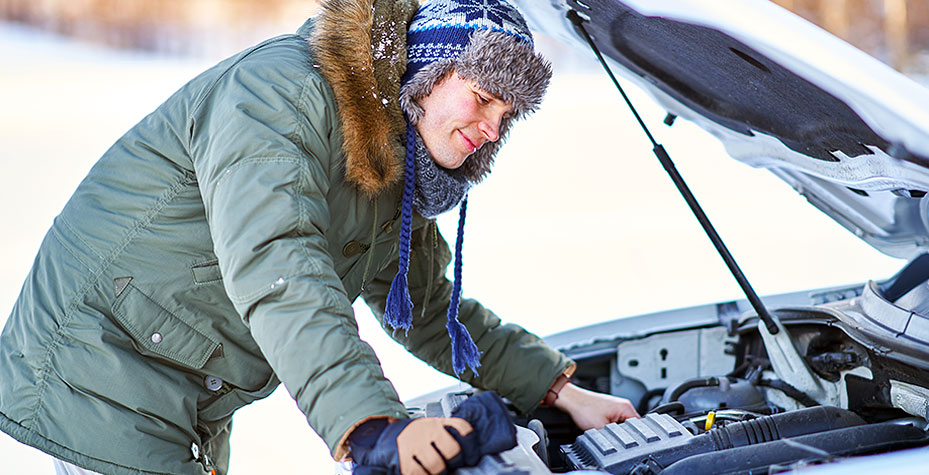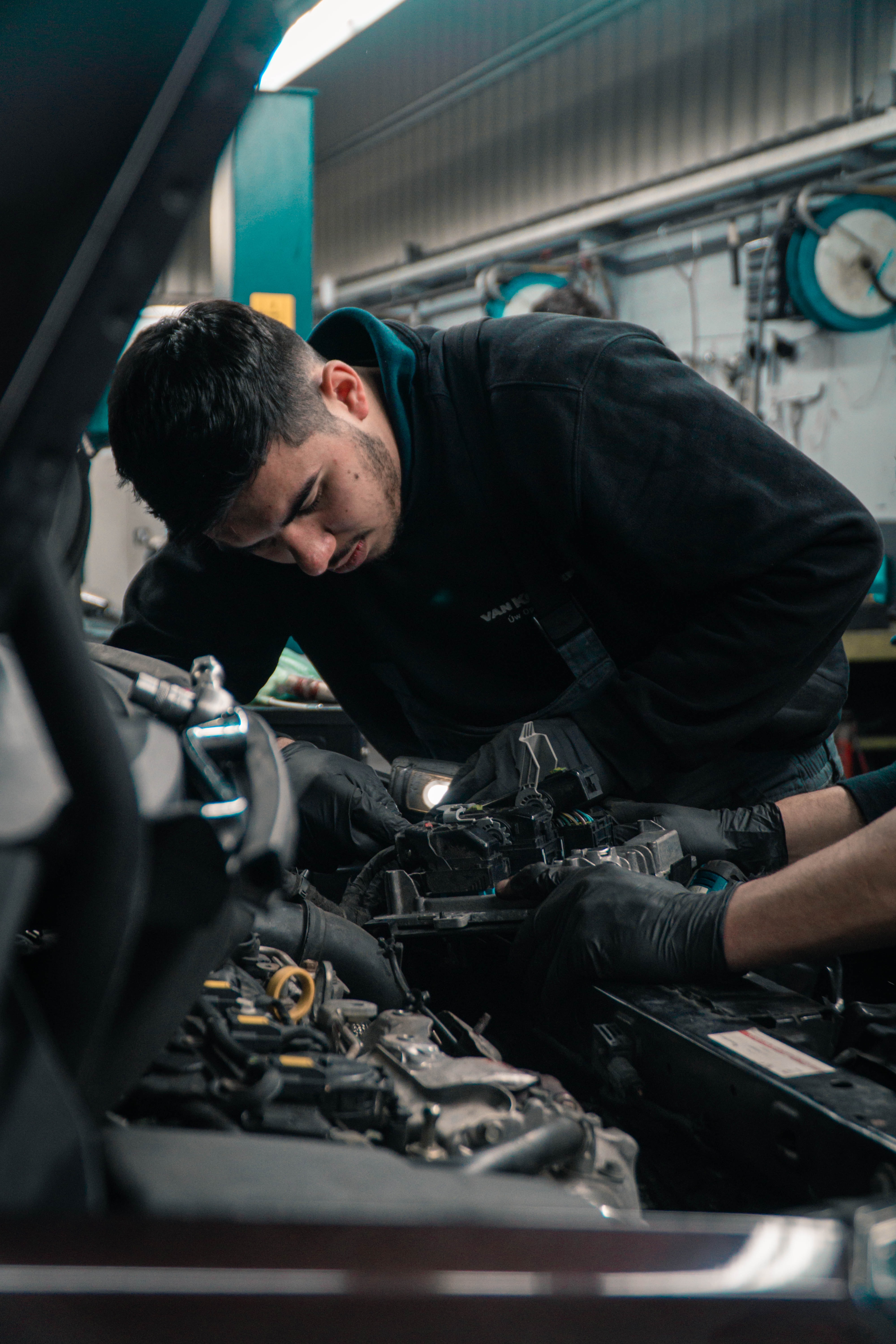
For most people, the changing seasons bring new weather and harsh conditions that can be rough on cars. Seasonal car maintenance will protect your ride on long drives from everything mother nature can throw at it. Here are some simple vehicle maintenance tips to remember as you turn the pages of your calendar.
The Chill of Winter
Winter is one of the worst seasons your car can experience, especially if you live in a northern region.
Cold Temps Increase Stress on the Battery
When the mercury drops, the chemical reactions inside your battery slow down, making it less efficient. This can make it more difficult to start your car because the battery is providing less power than normal. It also means that the battery takes more time to recharge.
Winter Can Harden and Crack Tire Rubber
Your car’s tires become harder and less flexible in low temperatures. Over time, cold, hard, and brittle tires can start to crack. Also, cold weather makes the air in your tires compress and provide less pressure, causing your tires to squish and feel mushy through your steering wheel.
Your Engine and Transmission’s Fluids Get Thicker
All the fluids your car relies on to operate smoothly get thicker and more viscous in the cold, which means the fluids will take longer to warm up, and there’s more friction. Even fuel will thicken up and potentially cause poor combustion, leading to lower fuel economy and engine damage.
Winter Vehicle Maintenance
There are several steps you can take to make sure your car gets through winter unscathed.
Care for and Test Your Battery
Park in a garage, preferably an insulated one, or put a cover over your car, especially overnight. Make sure you don’t leave lights or accessories on without the engine running. Unplug phone chargers and other power cords, these could drain your battery. Also, test your battery to ensure it’s running at 12.6 volts or higher. If it can’t maintain that charge, you should replace it as soon as possible.
Get the Right Tires, Maintain Your Current Ones
Get winter tires, which are designed to withstand the frigid temperatures. You should also check your tire pressure during wintertime and make sure they’re at the right operating pressure.
Make Sure Engine and Transmission Have Easily Flowing Oil
There are additives you can put in engine and transmission oil to keep it flowing properly. Additionally, anti-thickening additives in your fuel can optimize cold-weather combustion. Fun fact, the W in the oil (such as 5W30) stands for Winter. This tells you your viscosity level when an engine is cold. Oil that is thinner can flow easier and faster.
Keep After Rubber Parts, Especially Wipers
Inspect rubber parts to see that they aren’t worn or breaking, including hoses and belts in the engine compartment. As for your car’s windshield wipers, you should get winter wiper blades, which are made of silicone to resist water. They also have stronger hinges to address the excess weight of snow and ice.
Wash Salt From Your Car
While road salt is excellent at increasing traction, it will corrode metal parts on your car. Wash your car frequently to get that freshly applied salt off of the undercarriage.
Embracing Change in the Spring
How could there be any vehicle maintenance tips for spring? It’s more straightforward than you might think. Spring brings rain, pollen, and rough roads. Seasonal car maintenance is just as important in spring as it is in winter.
With Rain Comes Flooding, and Flooding Is Destructive
When water gets into places it shouldn’t, it can short out electronics and cause premature corrosion in hard-to-reach places. If water gets into the engine, it can become completely destroyed.
Pollen Can Eat Paint
Pollen is acidic. As such, it can erode the clear coat and stain your car’s finish.
Winter Thaw Can Break Apart Roads
When water seeps into the cracks in roads, it can freeze in winter and expand. This makes the crack even larger, leading to potholes.
Rust Can Form Thanks to Moisture and Salt
Even if you’ve kept up with washing road salt off your car, snow and ice can sit on vehicles for days, weeks, and even months at a time. All that moisture can cause corrosion.
Spring Car Maintenance Tips
Here’s what you have to do to keep up with vehicle maintenance when spring showers arrive.
Clean Inside and Out
Of course, washing and waxing are important for protecting the outside of your car. Benefits of waxing include sun protection, rain protection, keeping your car cleaner for longer, and increasing resale value. While cleaning and waxing are important, don’t forget the inside of your vehicle, too. Snow and road salt can cause carpets to discolor and break down. And extra moisture from melted snow can cause mold and mildew if you’re not careful.
Time for New Wiper Blades
Once winter ends, you won’t need those winter wipers on anymore, as the sturdy frame and synthetic rubber are not necessary for summer weather. Since they’re more expensive than regular wipers, it’s best to save them for the cold season. Go back to regular wipers that can handle excessive amounts of rain.
Your Tires Need TLC
If you have winter tires, it’s time to switch to all-season or summer tires. Winter tires have deeper treads and move grooves to increase traction in the snow – as well as a rubber compound that performs best at temperatures below 45 degrees. Winter tires have increased friction that can affect gas mileage, and therefore it is best to switch to a summer tire during the warmer months. Spring is the perfect period to rotate those summer or all-season tires and have the alignment checked. Driving through ice and snow can cause your alignment to drift.
Clean and Inspect Headlights
Give your headlight glass a good cleaning to ensure your headlights are as bright as they should be. Also, check the bulbs to make sure they’re working properly.
The Summer Strain
Summer can be just as harsh as the other seasons, so don’t skip your seasonal car maintenance.
How Extreme Heat Can Hurt Your Engine
The additives in your oil are heat-sensitive, and extreme summer heat can break them down. The result is sludge that can clog your engine’s oil passages.
The Negative Effects on the Coolant and Radiator
Just as super low temperatures damage belts and hoses, so can super high temperatures. And coolant leaks can cause engines to overheat, seize up, and end up destroyed.
Maintaining Your Tires
In winter, your tires can become underinflated. In summer, the opposite happens. When tires are overinflated, the tread patch reduces, causing tires to lose grip.
Make Sure Your Air Conditioning Is in Excellent Condition
Examine AC compressor belts. If they’re worn, they could break, leaving you without cold air in the hottest months. Have your mechanic check the refrigerant in your AC system for leaks as well.
Summer Car Maintenance Tips
Here are some important vehicle maintenance tips to keep your car comfortable during summer.
Check Your Tires
Make sure the tire pressure isn’t too high in the heat. You can also use summer tires, which are designed for maximum grip in hot conditions.
Test Your Air Conditioning
Before summer hits, make sure your AC can lower the temperatures in your car before it gets too hot outside.
Get a Sun Filter
Putting a sun filter up on the dash will keep temperatures down inside when you park your car. It will additionally protect interior bits from constant UV exposure.
Check the Fluids
Make sure all the fluids are topped off, especially coolant.
Change the Oil and the Filter
Change the oil, particularly if it has winter-temperature additives. Those additives aren’t necessary during a hot summer.
Fall Seasonal Vehicle Impacts
There are even essential vehicle maintenance tips for fall. These include:
Check for Leaves and Debris
Look for leaves at the base of the windshield, in the engine compartment, around the trunk lid, and any other nooks or crannies.
Get Ready for Winter
Change out necessary fluids, especially those that need additives, to keep them flowing in cold temperatures. Wash and wax your car to protect the finish from snow and ice. Replace damaged belts, hoses, and other rubber parts, too.
Fall Vehicle Maintenance
With fall, you have one last chance to do preventive maintenance without working in frigid temperatures.
Clean the Leaves
Get a vacuum and suck out the leaves and twigs. Pull them out by hand where needed.
Check the Tire Treads
Take a penny and face Lincoln toward you. Turn the penny upside down and stick it into a groove headfirst. You should not be able to see the top of Lincoln’s head. If you can, your tires’ grooves are too shallow.
Tune Up Your Brakes
Your brakes absorb road salt and other contaminants all winter and summer long. Get them a tune-up so you can stop in slippery winter conditions.
Check and Change Fluids
From brake fluid to transmission fluid to engine oil, it’s important to ensure that all of your car’s fluids are correct and topped off.
Year-Round Maintenance Tips
As important as seasonal car maintenance is, cars can suffer damage any time of the year. Here are some vehicle maintenance tips for all seasons.
Get Regular Inspections
If you live in a state that doesn’t have required inspections, you should still get your car inspected routinely. These evaluations can find issues you didn’t even know your car had.
Change Fluids and Filters
Stay on top of your car’s fluids, from windshield wiper to brake fluid. They are all necessary for keeping your car going without issue day after day.
Stay on Top of Oil Changes
Without oil, your car becomes a car-shaped paperweight. Measure your mileage and keep track of any additives in your engine oil.
Protect Your Car Thanks to CarShield
Routine maintenance is something you have to stay on top of, be preventative and check your vehicle's maintenance schedule. But for those unexpected issues a Vehicle Service Contract can protect you against costly repairs. CarShield has protection plans that fit any budget, you can choose which one is right for you. Contact CarShield today to get a free quote!








